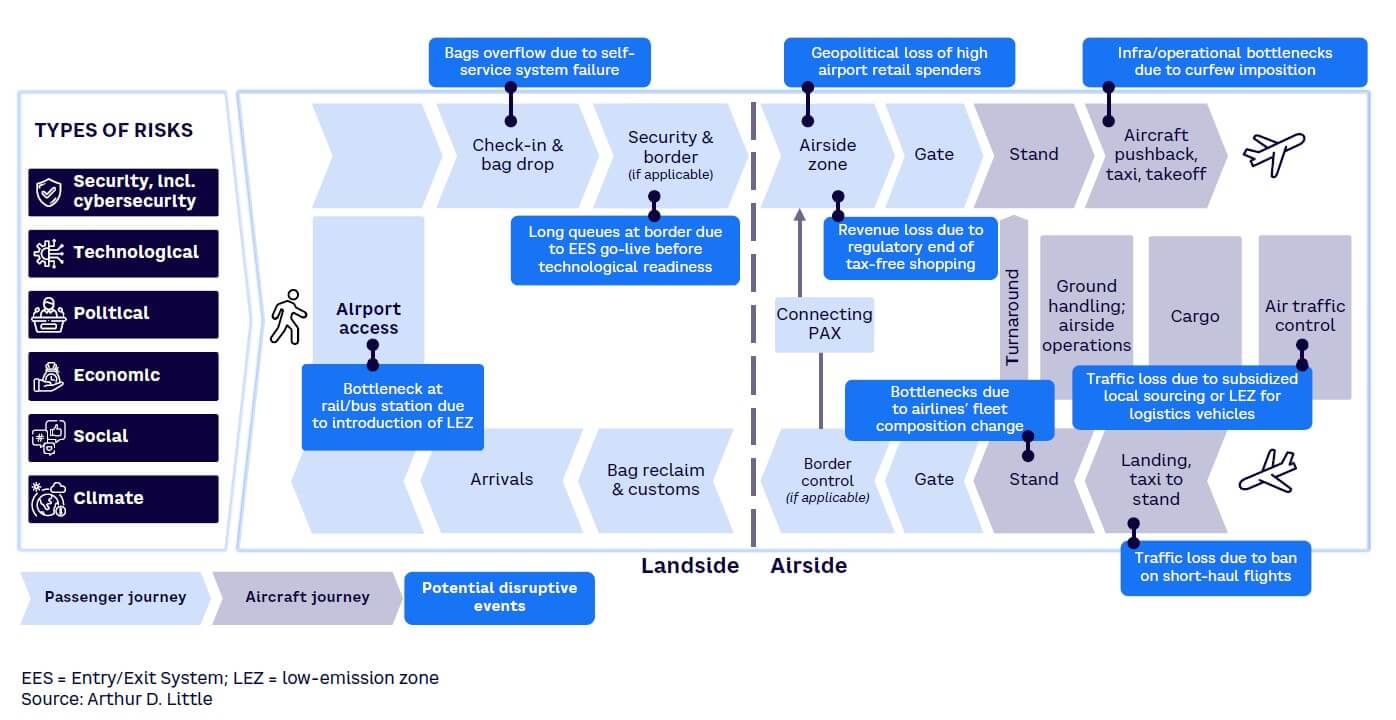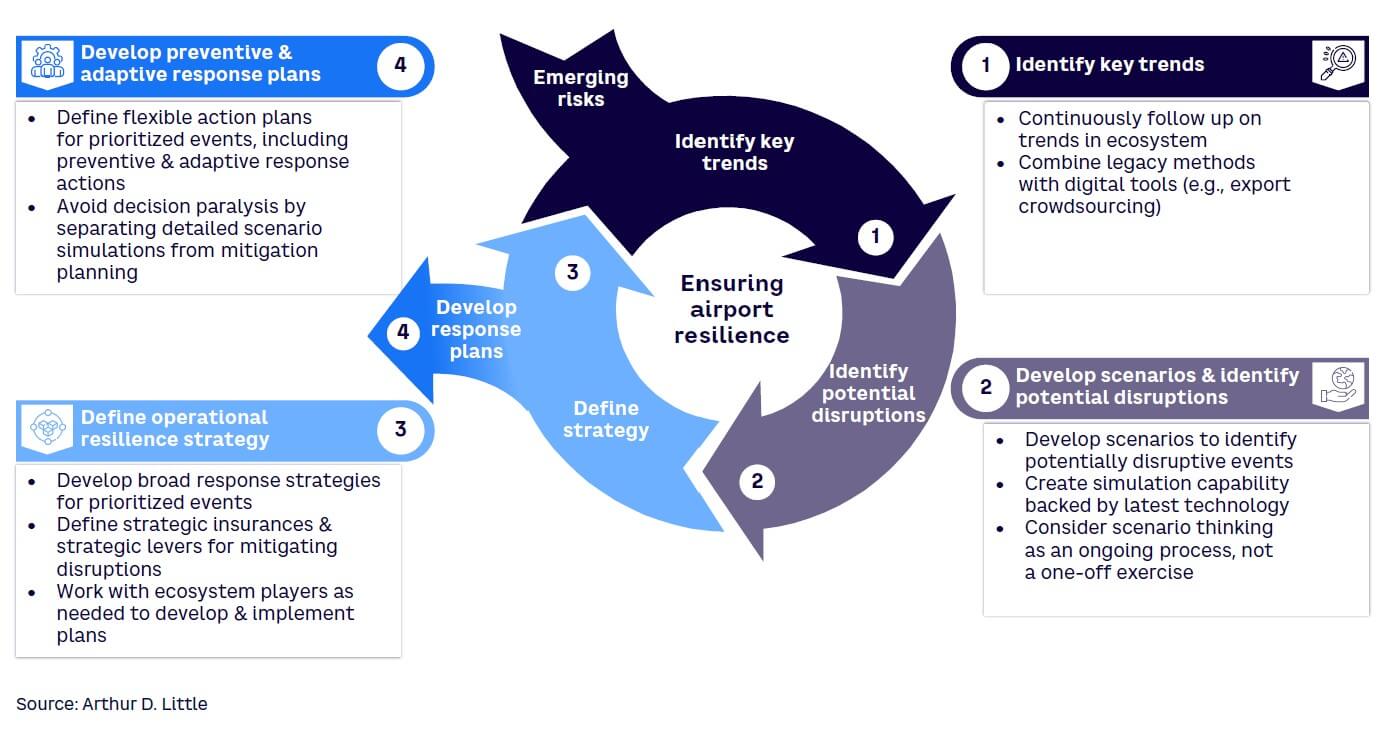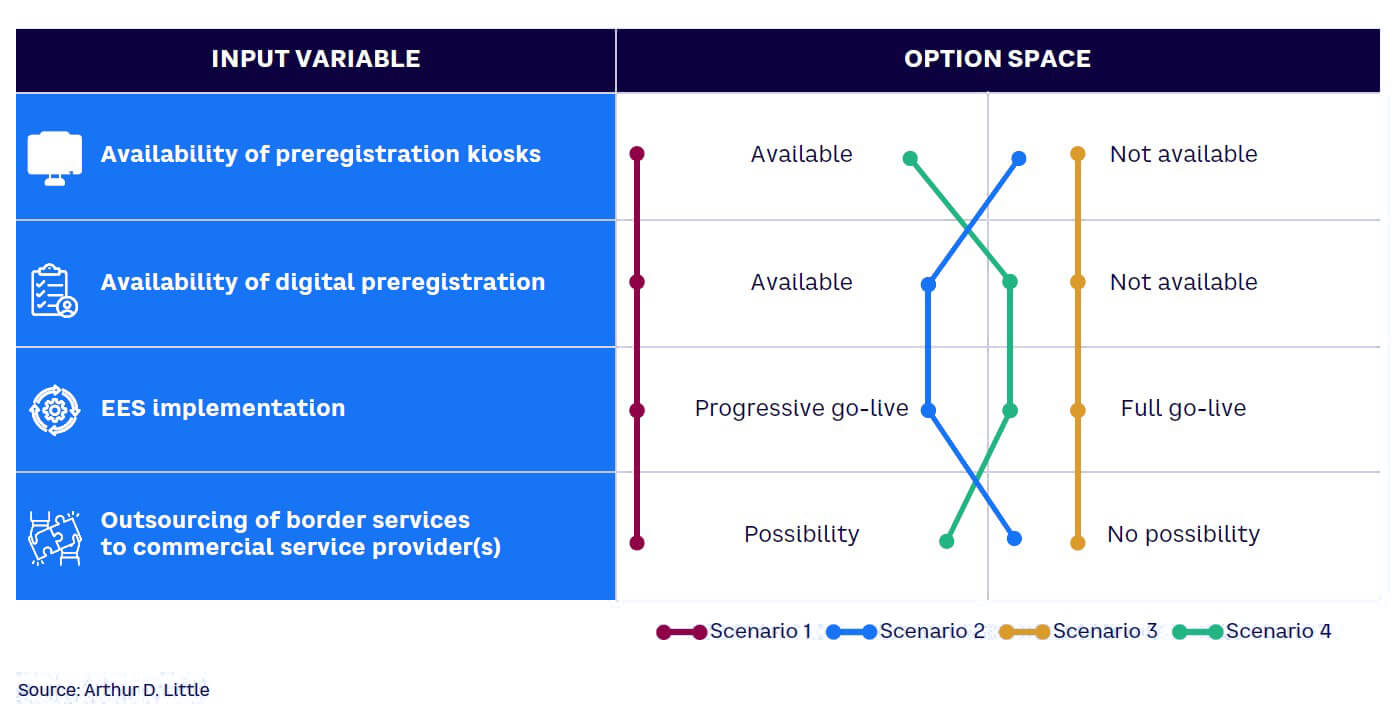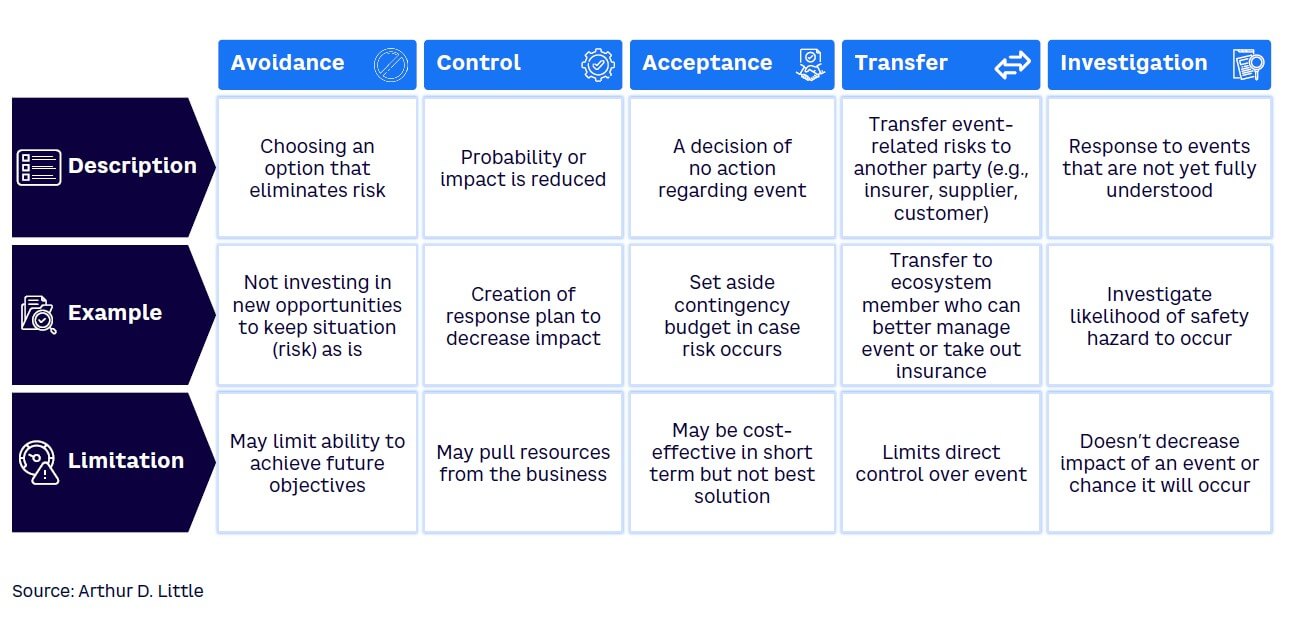
Even as it resurges, air travel faces new risks and regulatory changes that will necessitate more resilient airport management. In this Viewpoint, we propose a four-step approach to help airport executives handle emerging risks by making their operations more resistant to disruptions and better prepared for any future.
HIGH-STAKES RISKS & POTENTIAL DISRUPTORS
As air travel returns to pre-pandemic levels, airport ecosystems are increasingly exposed to external risks. Many risks are well-known, generally falling into security, cybersecurity, technological, political, economic, supply chain, social, or climate categories. But when we take a closer look, we see new complexities that may lead to disruptive events across numerous stages of passenger and aircraft journeys. Figure 1 shows the broad risk categories and highlights the types of disruptive events likely keeping airport executives up at night.

Some events relate to the adoption of infrastructure legislation. For example, in Europe, the Critical Entities Resilience (CER) Directive will come into effect later this year and will almost certainly require EU countries to identify airports as critical assets and provide assurance that risk management and business continuity strategies are fit for purpose and effective.
Sustainability issues are another major concern. Most passengers arrive at the airport via private car, so airports tend to be highly connected to highways and feature multiple drop-off zones and parking opportunities. Today, environmental concerns and road congestion are leading governments to push hard for more sustainable transport, with some considering mandating ultra-low emission zones (ULEZs) around airports. These mandates have a substantial negative effect on access, causing passenger surges at airport rail stations and bus stops and creating an urgent need for better micromobility infrastructure.
Some airports face issues related to climate change, such as severe flooding from rainfall, high temperatures damaging runways or aprons, or the need to manage snowfall and iced-over planes in areas that previously did not often experience wintery conditions. Moreover, airports in densely populated areas are dealing with concerns about noise pollution, with discussions of curfews being imposed to limit aircraft movements and operating hours.
The trend toward more fuel-efficient narrowbody planes that can fly widebody routes has already forced airports to reshuffle their stand and gate capacity (which they previously heavily invested in), yet it is unclear whether widebody aircraft will continue to be manufactured or will completely disappear.
Another sustainability-driven risk is a regulatory ban on very short-haul flights or flights with valid alternatives (e.g., train, bus) that could be imposed by regulators. This would undermine the hub-and-spoke operating model of many airports, directly impacting top- and bottom-line performance and forcing them to launch an attractive, seamless train-to-plane product to safeguard passenger volumes and revenue.
Sustainability is also driving changes in cargo handling. Some airports may see lower air cargo volumes due to government subsidies for businesses that source local products. Low-emission zones for logistics vehicles or more stringent CO2 emission standards could greatly affect the use of heavy-duty vehicles in getting goods from the airport to a warehouse or other destination, to the point where airports must build dedicated rail stations to offload cargo.
On the technology side, decentralized offerings such as kiosks and mobile apps for check-in, home luggage pickup, and 24/7 luggage drop-off outside the airport are raising concerns about reduced hospitality, cybersecurity and physical security threats, and increased maintenance requirements, making the future of fully automatic self-service offerings uncertain and operations even more complex.
Of course, airports also must be ready to process 100% of passengers in the terminal if an online check-in/bag-tag system fails due a cyberattack or other issue.
Plus, there is the trend toward stricter controls around passenger security screening and border clearance. New technologies will be coming to market, including walk-through body scanners and biometric/AI support for border crossings, but many fear the technology will not be in place in time to mitigate disruptive events at airports. For example, the EU announced that its Entry/Exit System (EES) will go into effect in November 2024, and some experts are concerned it will cause long lines at airports on European borders.
Finally, revenue generation is a major concern for airports, with some seeing a drop in high spenders (e.g., Chinese and Russian passengers) due to geopolitics and others experiencing disruptions caused by local regulations (e.g., the recent end of tax-free shopping for international visitors in the UK).
4-STEP APPROACH TO STAY RESILIENT
Figure 2 illustrates the Arthur D. Little (ADL) four-step Airport Resilience Cycle that emphasizes an integrated approach to building resilience. Below, we describe each step in further details.

Step 1: Identify key trends
The first step in boosting resilience is ensuring a comprehensive understanding of external trends as they evolve. This may require setting up a small internal think tank and establishing an organizational procedure for ongoing monitoring and interpretation of technical, regulatory, and market information. This is followed by clear communications of potential threats that require the attention of senior management. This practice is common in many organizations in a variety of industries but often lacking in airports and other CAPEX-driven businesses that rely on a rigid routine of x-year business planning.
However, fixing the basics may not be sufficient to gain a competitive edge. Some organizations have considerably enhanced their trend-recognition abilities by implementing newer methods that harness the latest technology. A notable example is expert crowdsourcing, which complements existing platforms like A-CDM (Airport Collaborative Decision-Making) and TAM (total airport management). Data analytics and machine learning allow airport executives to involve a much larger and more diversified group of experts than any conventional method; this approach greatly reduces the chance of overlooking important external developments. (For more on this topic, see the ADL Prism article “Take Off or Trough?”)
Step 2: Develop scenarios & identify potential disruptions
Historical data is insufficient for accurately predicting how trends will evolve. Thus, the second step is to use scenario planning to generate more informed decisions while staying agile and adaptable. It includes:
- Listing variables that could determine the outcome of identified trends
- Considering likely combinations of those variables, including extreme scenarios
- Simulating and estimating the impact (level of disruption) the trend may have on the airport
- Determining whether the trend is likely to lead to a disruptive event that could derail normal operations
As with trend recognition, data analytics and AI are useful here, letting airport executives quickly simulate potential impacts in multiple scenarios. Moreover, as soon as some variables of more uncertain trends become clearer (or new important inputs arrive), the simulation process easily can be rerun to help airports prepare for a potential disruption. Importantly, scenario planning should be seen as an ongoing process, not a one-off exercise (see sidebar “Scenario planning use case: EES” for an example of scenario planning in action).
Scenario planning use case: EES
In an effort to strengthen its borders, the EU is implementing the EES for registering travelers from third countries each time they cross an external border (a third country is either not a member of the EU or a country/territory whose citizens do not enjoy the EU right to free movement). As individuals from third countries enter/exit the Schengen area (the area where EU citizens can move around without being subject to border checks), they will be subject to biometric scans and asked to fill out a questionnaire.
Timely availability of technological solutions that allow passengers to prefill necessary data before approaching the border crossing will be key differentiators (preregistration kiosks/application).
Similarly, much will depend on whether the EU makes this change in a single step (i.e., all third-country nationals at once) or launches it gradually (e.g., a random 10% of passengers in the first months with a gradual increase). Another lever is manpower increase by outsourcing some border control operations to private firms, which typically allows for significantly faster resource upstaffing and capacity.
Because these variables are under the control of various public authorities, airport managers are hard pressed to make accurate predictions about how the EES launch will go and whether it will cause long waits at border crossings. Figure A shows how scenario planning can help airport managers simulate myriad outcomes and determine the likely level of disruption in their area.

Step 3: Define operational resilience strategy
Potentially disruptive events should be examined first from a high level to avoid getting bogged down in the details of multiple separate contingency plans. This stage could include the following sub-steps:
- Set up strong response strategies — for potentially disruptive events (e.g., avoidance, control, acceptance, transfer, investigation) while considering your risk appetite for various risk categories identified (see Figure 3)
- Define strategic insurances — no-regret actions relevant for multiple potentially disruptive events that can be prepared in advance to safeguard operations during an emergency
- Define strategic levers — means or capabilities that address several potentially disruptive events rather than one specific event

Each response strategy must connect to the airport’s overall strategic goals, business model, and risk appetite. For example, if cargo operations are only a small part of an airport’s portfolio, it might opt for an acceptance strategy around risks related to government programs promoting local sourcing.
In contrast, if an airport emphasizes its convenience as a travel hub, it must maintain control of its border and security-screening timing. That means it can’t accept uncontrolled risks like EES-related disruptions — this would directly affect the airport’s minimum connection time key performance indicators (KPIs) and have an immediate negative affect on the airport’s attractiveness to airlines and passengers.
An excellent example of strategic insurance is an integrated queuing information system. Many disruptive events lead to increased wait times, whether at initial check-in, security screening, or border control. A queuing information system that provides passengers with expected wait times from the moment they enter the airport until they board the plane helps manage travelers’ expectations and calm their anxiety. Such a system might include airport displays, digital communication, alerts about delays several hours before flight time, and automated communications with airlines to ensure information gets to passengers in real time.
Creating express lanes for passengers who would likely miss their connecting flights is another option for handling disruptions. Ideally, the systems created to inform passengers about wait times and express lanes will be automatic, rather than manual, with physical screens at terminals indicating which flights are critical and, hence, which passengers can make use of the express connection lane at screening and/or border control by, for example, scanning their boarding pass at automatic gates. However, this could have financial repercussions for both airlines and airports, as “premiumization” can be an important revenue stream.
Strategic levers involve influencing a specific trend to ensure that the most favorable scenarios materialize. For example, an airport might lobby organizations and government agencies to try to shape regulations involving border and screening controls. This may mean triggering frequent discussions with industry organizations (e.g., ACI [Airports Council International]) on what to expect of a new regulation, working to create a unified position within the sector toward new statutes, and/or interacting with legislators and authorities to ensure that any strict requirements are implemented at a reasonable pace and supported by appropriate resources.
In many cases, response-strategy implementation will require integration with the rest of the airport ecosystem (e.g., airlines, baggage handlers). In any ecosystem, the weakest link tends to influence overall performance and experience, so an airport, as the most stable player within its local ecosystem, is essentially the “guardian” of the ecosystem’s overall resilience. For example, if an airport wants to implement the express connection system described above, it must coordinate a joint effort involving airlines, handlers, border and security staff, and others.
Step 4: Develop preventive & adaptive response plans
The final step is creating detailed response plans for events in the “control” area of response strategy shown in Figure 3. We recommend a risk-analysis methodology including:
- Identifying key causes/risk factors that lead to the disrupting event
- Defining preventive measures that could stop the event from occurring or shape the event into a more desirable form (e.g., reduced in size/delayed)
- Estimating/simulating the expected size of the event, with and without preventive measures, to help define priorities and required resources
- Defining adaptive/responsive measures or recovery actions that could be implemented to minimize the consequences or impacts of the event if it does occur
- Using key risk indicators to assess whether the risk of critical root causes are increasing or decreasing
- Assessing the effectiveness of each preventive and adaptive response measure, identifying potential gaps or weaknesses and adjusting as required
For example, suppose a government imposes a ULEZ around an airport to reduce air pollution for neighboring areas. This happened at Heathrow (London) and Schiphol (Amsterdam) and could certainly occur at other airports in densely populated territories. If all vehicles entering the airport had to adhere to specific emissions standards, airport accessibility would be significantly disrupted. It would certainly lead to overcrowding at public transport stations as passengers switched to alternative modes of transportation.
To prevent high disruption levels, airports might respond by negotiating a gradual go-live with transport authorities, so that for a certain period (e.g., two years) passengers could pay a surcharge for entering the airport with a vehicle that does not meet the standards. An example of an adaptive response action would be foreseeing the need for additional parking outside the ULEZ that connects to the airport via an ULEZ-compliant shuttle (train or bus) that operates 24/7 to ensure the airport remains easily reachable by travelers.
In today’s rapidly changing landscape, airport managers need systems that help them avoid becoming paralyzed by uncertainty. This means less focus on the accuracy of their assumptions and not aiming for a perfect action plan. Instead, managers should separate the forecasting and scenario-building process (described in Step 2) from mitigation planning. In other words, actions should be concurrently developed and categorized then activated based on the magnitude of the event when it occurs.
Conclusion
AN INTEGRATED APPROACH TO INCREASING RESILIENCE
As the diversity and magnitude of risks that may affect aviation increase, airports can enhance their resilience by adopting an integrated approach, focusing on:
- Setting up robust, digitally enabled trend-monitoring routines
- Applying ongoing scenario thinking
- Defining the right system-level strategies for potentially disruptive events
- Developing flexible preventive and adaptive response plans
This approach does not necessarily require significant resources, but it does require development of capabilities most airports don’t have, including expertise in horizon scanning and simulations, risk assessment, and short/medium-term action planning in a multi-stakeholder environment. For increased resilience, airports are thus now set to add future-proofing and proactive ecosystem management to their to-do list after decades of a strong focus on long-term infrastructure and commercial development.








